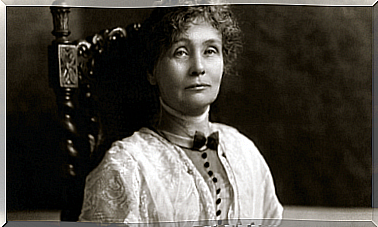Chronic Traumatic Encephalopathy, Or Boxer’s Dementia

Chronic traumatic encephalopathy is a neurodegenerative disorder. It has gained attention in recent years as researchers have discovered more about the effects of playing certain sports. The other name that is used, “boxer’s dementia,” gives you a clue as to its etiology.
The repeated blows to the head during the boxing career can be the cause of this type of dementia. While it is difficult to calculate exactly how often an athlete who engages in contact sports receives a blow to the head during his or her career, it is not difficult to imagine the consequences of these repeated blows.
Multi-trauma and repetitive concussions lead to cortical atrophy of the brain, causing chronic traumatic encephalopathy.

General characteristics of boxer’s dementia
In 1928, pathologist and medical forensic scientist Harrison Martland was the first to describe the condition clinical boxer’s dementia. Today, scientists categorize it as a variant of chronic traumatic encephalopathy.
In the beginning, however, no distinction was made between the two. Researchers noticed the distinction when they realized they only saw Boxer’s dementia symptoms in certain groups.
A silent disease
The popularity of boxing in the early 20th century inspired many experts and fans to get involved in the sport. At first, its effects went unnoticed. However, over the years, the number of cases of people with symptoms began to rise.
The most common symptoms were apathy, psychotic features, loss of coordination and marked global intellectual disability. Scientists linked these symptoms to repeated brain microinjuries caused by concussions.
The development of chronic traumatic encephalopathy
Cortical atrophy of the brain leads to an overall reduction in brain size. It also slows down the metabolism. In general, cortical atrophy affects all brain structures, negatively impacting overall functionality.
This disease is progressive and the symptoms can vary, as we can see here.
- Early stage. The patient experiences the first symptoms of cognitive impairment from multi-trauma to the head. Although there is no clear “start date” of the disease, the patient tends to be latent during the early years.
- Advanced stage. Experts believe that the advanced stage usually begins about 12 to 16 years after the patient has taken up the sport. By then, the symptoms will be apparent, but they cannot yet be categorized as dementia.
- dementia. The symptoms are established and affect all aspects of the patient’s functionality. Loss of mental faculties such as memory and reasoning become apparent and significantly affect behavior.
Main symptoms
The symptoms of boxer’s dementia vary, so it’s easy to confuse them with those of other neurodegenerative diseases. Also, dementia patients tend to share a group of symptoms, which become more pronounced over time. These include:
- General apathy. Lack of emotional expression or interest, accentuated by impaired communication skills.
- Aggressiveness. Physical and verbal aggressiveness, patients also become impulsive and irritable.
- Depression. The progressive nature of the symptoms often leads to loss of motivation, as well as feelings of isolation and despair.
- Memory. Patients have the most difficulty with their daily tasks. Memory changes are associated with problems with attention and focus.
- Motor Problems. At first, patients just seem a little clumsy or careless. Over time, however, they become slow, stiff and uncoordinated.
Primary risk factors for chronic traumatic encephalopathy
The main risk factor for developing this type of dementia is participating in contact sports. Despite the name, boxing is not the only sport that can cause this. There are also other sports that put athletes at risk, namely:
- american football
- kickboxing
- motorized racing sports
Other risk factors also include:
- starting a contact sport at a young age
- not using the protective clothing that experts recommend for the sport
- a long sports career
- not practicing prevention strategies
Diagnosis
Boxer’s dementia is not related to one specific injury or area of the brain. Therefore, it is difficult to diagnose.
A neurologist and a neuropsychologist usually evaluate the patient for their behavioral and motor symptoms. Doctors also use neuroimaging (such as CT scans) to determine the extent of brain damage.

Therapy
The primary treatment for boxer’s dementia involves avoiding the risk factors. If you play any of the above sports, you should take all possible measures to protect yourself and be careful.
If a patient already has symptoms, there are two common approaches:
- medicalization. Treatment with pharmaceutical agents that address specific symptoms.
- Revalidation. The patient should start treatment as soon as possible to take advantage of the brain’s plasticity. Therapists usually focus on teaching ways to compensate for the patient’s loss of motor skills. The goal is that they continue to function as normally as possible.
Some things to consider
Boxer’s dementia is a very clear example of what happens when you don’t take good care of your brain. The changes show up in the long run, but the causes happen early in life.
The lack of direct consequences makes it difficult to be fully aware of the damage. However, any activity that affects the nervous system will take a heavy toll on your body over time. Eating right is a very important preventive method for any form of dementia.
Finally, it is important to remember that some very popular sports are not necessarily healthy. That’s especially true if you don’t take the proper precautions. A large percentage of former American football players have traumatic brain injuries. Their sports career will negatively affect them for the rest of their lives.
In conclusion, we can say that thanks to new studies and an increased awareness of the risks, the athletic community is taking measures such as providing compensation for former players and investing more money in research.









